The term Street Art encompasses art forms made in public places that are not normally set aside for artwork, e.g., walls, streets, and squares. The earliest works of Street Art are generally traced back to the 1980s although there is no shortage of earlier examples, and the current has now spanned several decades assuming increasing importance and diversifying in techniques. Initially, in fact, these interventions were often unauthorized, and artists were frequently accused of vandalism. Recently, however, street art has been recognized as art in its own right and valued. After all, works of this genre have definitely increased in number, becoming part of people’s daily lives and succeeding in influencing trends and media. Thanks to the spread of smartphones and social networks, and consequently the possibility of immortalizing works in real time, street art today often becomes “viral,” meaning that it is spread and known very quickly, meeting the approval of millions of people around the world who share the messages represented.
Over the years, the difference between graffiti and street art has become increasingly clear, whereas at least until the 1990s they were both lumped together under the name “graffiti art.” Writers, or graffiti artists, work mostly with spray paint and elaborate mainly on lettering, with an emphasis on lettering and “tagging,” the signature they apply to their work, curated so that it is recognizable and expresses the writer’s own personality. In addition, the world of writers is closely related to hip hop culture, which originated in the United States in the 1980s. Street art, on the other hand, is characterized by a wide variety of techniques, namely painting, application of materials (tiles, stickers, and many others), sculpture, and spray paint, and is based on different goals and concepts. Most often, Street Art exponents connote their works with messages of denunciation, especially toward government policies or particular injustices they find in society. Moreover, many artists deliberately choose this art form for the opportunity to work in total autonomy and to free themselves from the constraints placed by galleries or museums, with the added advantage of being able to reach a much wider audience.

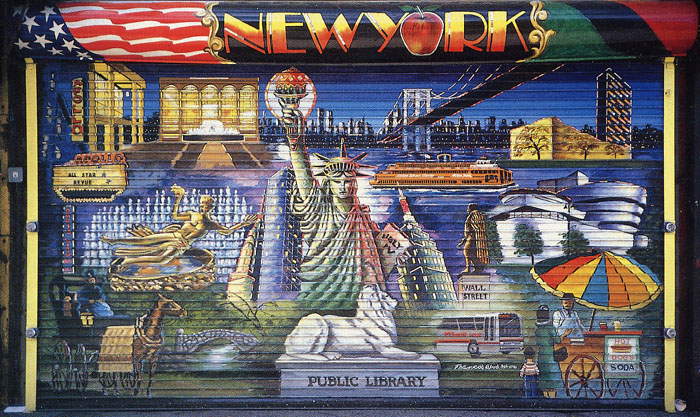
Between the 1980s and the 1990s, the phenomenon of Street Art spreads and from an act of vandalism becomes in effect an art movement. But on closer inspection, Street Art as a concept, that is, the presentation of works of art in public settings and accessible to all, was born many years earlier, in the 1950s and 1960s. This was an era characterized byexperimentation and more conceptual implications of the artistic message, a time when artists first began to really challenge conventions and greatly reduce the barriers between audience and artist.
The artist Christo himself, who in those years hid a number of famous buildings from public view by aiming for an effect of great collective surprise, can be considered one of the precursors of Street Art, intervening directly in the urban landscape.
In the 1970s, moreover, public art manifestations increasingly took on political connotations, in line with protests and contestations against wars and capitalism. When, however, graffiti began to appear more and more frequently, it was already the 1980s. These were the years when mass media became preponderant, society was moving toward unbridled consumerism, and in this cultural context graffiti was sending social messages but could also be simply decorative. The stencil technique itself, which was initially used exclusively for slogans of denunciation, later became a favored mode of execution for any work, as it reduced the time required to produce it.
Street Art thus reached its peak in these years, and the focal point was the Brooklyn neighborhood in New York City, a particularly fertile ground for the presence of abandoned areas on which to act undisturbed.
It was then between the late 1990s and the 2000s that there was a trend in Europe for so-called graffiti writers or graffiti artists to expand their activities through modes other than graffiti, namely posters and wall paint. Not infrequently, graffiti artists began to collaborate more and more with photographers, poets, and other artists who had been polemical toward the impositions of the art establishment.
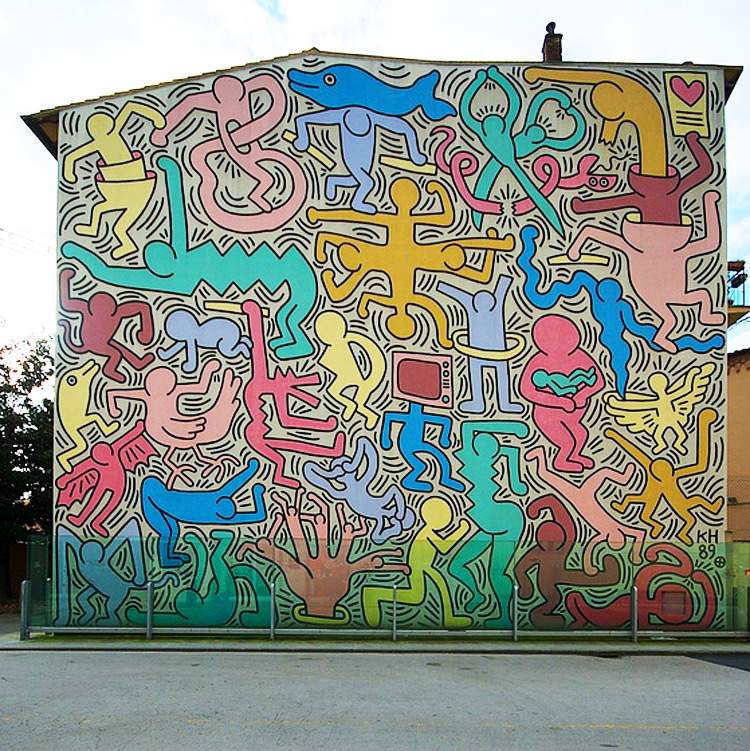

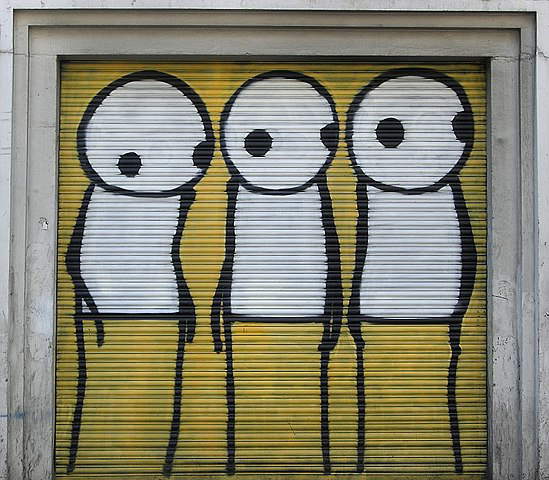

A Street Artist can come from a canonical artistic training path, or be totally audodidactic. Several of these artists have not revealed their identity, thus not even their training path, signing themselves with pseudonyms or acronyms and acronyms. One of the earliest American street artists can be considered René Moncada (Colombia, 1943), a self-taught artist who moved from South America to New York City in the 1970s, a decade in the late 1970s in which he began to make a number of murals, which often dealt with topics considered scandalous such as sex and violence. Strongly political art was that of Franco the Great (Frankin Gaskin; Panama, 1928), who made his murals in New York’s Harlem neighborhood,
The most important and famous exponent is certainly an American active in New York, Keith Haring (Reading, 1958 - New York, 1990). After training as an advertising graphic designer, a field that did not appeal to him, he began drawing on empty billboards he had noticed on his subway commutes. It was an important experience that allowed him to experiment and refine his technique. He thus defined the style with which he became wildly popular, consisting of stylized, two-dimensional figures to which he was able to infuse expressiveness and movement through very bright colors, typical of advertising graphics, and the use of lines pointing in various directions. This was a device used in comics to emphasize the movement of a character, or a moment in which he felt awe and joy. Through the immediacy of his figures and recurring symbols, such as the heart, the angel, the dog, the children, the television set, and the characteristic dark line that contours the scene, much like comic strip cartoons, Haring conveyed incisive messages about important issues, including capitalism, thedrug abuse, apartheid in Africa, and AIDS, a disease that greatly affected society in the 1980s and affected Haring himself, resulting in his untimely death. Haring’s works, at the same time, mostly convey positive feelings, of love of life and neighbor and happiness.
Not only was Haring’s style accessible to everyone, but so were his works, which he made on any surface he had at hand, even car bodies. Even today you can see his work printed on everyday objects, from clothing to furniture, so his art has become for all intents and purposes pop art, in the sense of folk art.
The other big name in street art and one of the first instances of using acronyms to sign his work is another New Yorker, Jean-Michael Basquiat (New York, 1960 - 1988). Admired and celebrated for the strong expressive power of his style, Basquiat both produced canonical works on canvas signed with his real name and produced several graffiti pieces paired with his friend and artist Al Diaz, on which they affixed the initials SAMO. His works were able to goad the viewer both by their themes, such as capitalist hypocrisy and existentialism, and by the figures, strident and brightly colored, highly expressive, snickering, laughing, shouting, painted as if they were expressions of instinctive urgency. Basquiat had developed a figurative interest in the human body since childhood, having been given Gray’s anatomy manual as a gift.
Other prominent U.S. names include those of John Fekner (New York, 1950) and Richard Hambleton (Vancouver, 1952 - New York, 2017). Street art has gained new momentum in the 2000s, especially in Europe and particularly in the United Kingdom and France. Particularly active in England are the scenes in London, dominated by the figure of Stik, and Bristol, whose most important figure is that of Nick Walker (Bristol, 1969), although universally known for the presence of Banksy, who has become, thanks in part to his commercial success, the most famous of the exponents of Guerrilla art, a branch of Street art characterized by the absolute anonymity of artists who intervene in the shadows on a given site. Indeed, the identity of Banksy, who has since been for all intents and purposes recognized as an artist and whose work has been auctioned for very substantial sums, is still unknown to this day, and all that is known of him is that he hails from Bristol, England. In France , the capital Paris is probably the most vital European city for street art, which spread here between the 1970s and 1980s thanks to artists such as Space Invader, famous for his works made with pixel graphics from 1980s video games, Blek Le Rat (Xavier Prou; Boulogne-Billancourt, 1952), considered one of the fathers of Stencil Art, and then again Speedy Graphito (Olivier Rizzo; Paris, 1961), Jef Aérosol (Jean-François Perroy; Paris, 1957), SP 38, Zevs. In France Street Art was able to develop thanks probably to the action of the Situationists who were already writing their slogans on the walls in the 1950s, and an important impulse, as mentioned, was given by the urban interventions of Christo and Jeanne-Claude.
Even in Italy, where, moreover, Keith Haring’s only work designed to be permanent, Tuttomondo in Pisa, a fervent Street Art scene has developed in several cities. One of the best known and most important names is Blu, originally from Senigallia (Ancona), reported by the prestigious Guardian in 2011 as one of the 10 best street artists ever. Even in his case, his true identity is not known.
His first works appeared in 1999 in Bologna, near the Academy of Fine Arts and in the premises occupied by the social center Livello 57, in the suburbs, making a real action of recovery of degraded areas of the city. These early works were made with spray paint cans, thus very close to real graffiti art, while from 2001 onwards Blu began to use tempera applied with rollers mounted on telescopic sticks, to reach great heights and extend the surface of the work. He thus signed impressive murals, which are developed on the facades of large buildings vertically or horizontally. Blu’s hallmark are human figures with ungainly features and often deformed features, with sarcastic or dramatic expressions. Usually the colors are somber and muted. The inspiration for his figures comes from the world of comic books and video games, and the themes depicted concern criticism of government policies and inequality.
One of the best-known Italian artists internationally is Millo (Francesco Camillo Giorgino; Mesagne 1979), who understands Street Art as “an art form that is legally and illegally appropriating the invisible places of our cities,” confirming the tendency to favor buildings on the margins of cities. Regarding the meaning of his works, Millo said, “I don’t have a unified message in my works, each work carries a different message and created specifically for the place where it will be located.” The Italian street art scene is, however, very rich, and in addition to the artists already mentioned, there are also Ericailcane, Ozmo (Gionata Gesi; Pontedera, 1975), Eron (Davide Salvadei; Rimini, 1973) and the Guerrilla Spam and Cane Morto collectives.
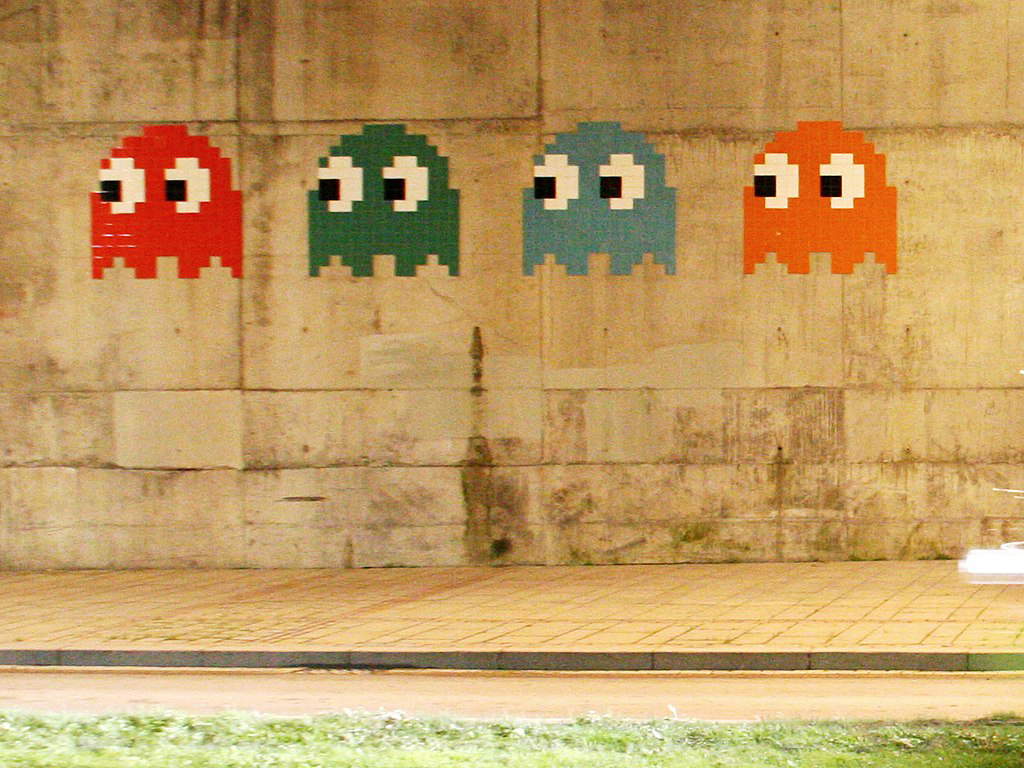


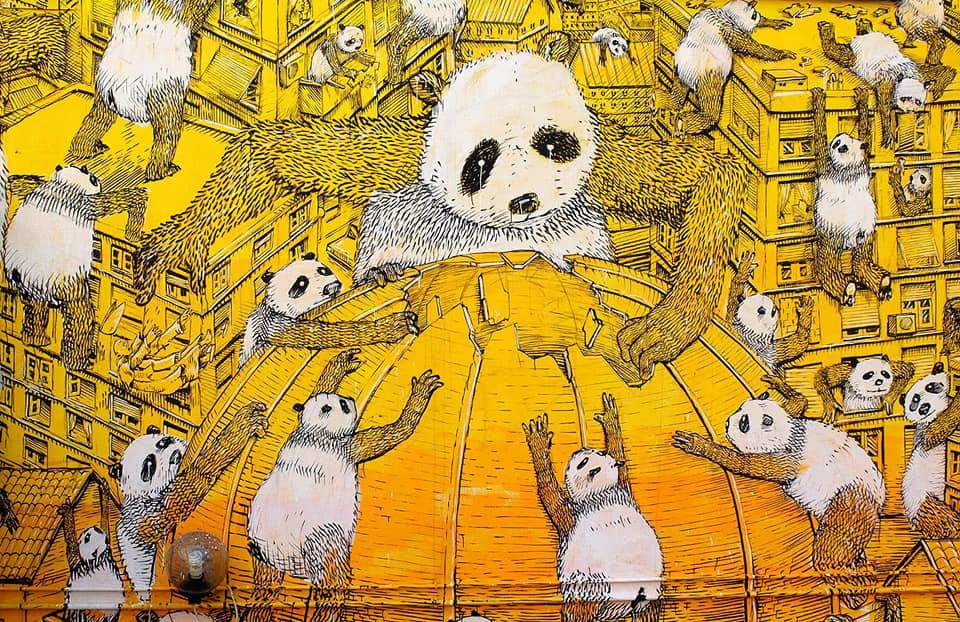

Attempts, more frequent in recent years, to bring Street Art on display in museums has generated a number of controversies, born mainly by the artists themselves, who are against the removal of murals from the context for which they were conceived. Rather, these have favored outdoor themed festivals that are organized around the world, including the Nuart Festival, which has been held in Norway since 2001, Living Walls, in the United States since 2009, and the Pasadena Chalk Festival since 2020, which entered the Guinness Book of World Records as the world’s largest street art festival.
Other notable international festivals include Urban Art, which takes place in Brixton, England; the Mural Festival in Montréal, Canada; the Bloop Festival in Ibiza, Spain; and Pow! Wow! in Rotterdam in the Netherlands.
Street art festivals are also held annually in Italy, including Frontier and Cheap Festival, dedicated to poster art (works on paper media), both of which have been active in Bologna since around 2012, while since 2017 there has been Borgo Universo in Aielli (L’Aquila), in which the village of the title is enriched with new murals each year.
 |
| Street Art: birth, development, major exponents of street art |
Warning: the translation into English of the original Italian article was created using automatic tools. We undertake to review all articles, but we do not guarantee the total absence of inaccuracies in the translation due to the program. You can find the original by clicking on the ITA button. If you find any mistake,please contact us.